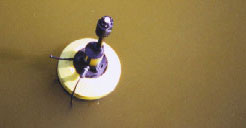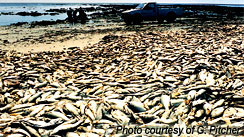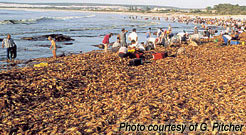|
|
|
|
|
 |
|
|
|
|
|
TOXIC DINOFLAGELLATE &
DIATOM BLOOMS
|
| Paralytic Shellfish Poisoning (PSP) |
|
|
- Organisms impacted by
PSP in this area include white and black mussels, anchovy, herring,
mackerel, and sardine. Toxins may also be transferred through
the food web to whales and seals. In March 1980, approximately
5 million white mussels were washed ashore at Elands Bay after
becoming toxic from an Alexandrium catenella bloom.
- An interesting feature about PSP in South Africa
is that their abalone industry is being threatened. This is perplexing
because abalone are not known to be filter feeders and do not
graze microalgal cells. Instead they feed on kelp. Research is
underway to determine how the abalone are picking up the PSP toxins.
One thing that is known is once the abalone acquire the toxins,
they do not get rid of them quickly. It may take up to a year
for abalone to be eaten safely. This ability to retain toxins
is similar to the butter clam found off of Alaska's coast.
|
|
|
| Diarrhetic
Shellfish Poisoning (DSP) |
|
|
|
|
|
|
| Neurotoxic
Shellfish Poisoning (NSP) |
 |
- The dinoflagellate Gymnodinium cf. mikimotoi
is present on the southern coast of South Africa and blooms frequently
in False Bay. This species causes NSP symptoms similar to those
reported during Gymnodinium breve blooms off the Florida
coast.
- Problems associated with these blooms include
skin and respiratory irritations.
- In 1989, 30 tons of abalone were killed on the
South Coast after a G. mikimotoi bloom.
|
|
|
 |
|
|
|
|
| Amnesic
Shellfish Poisoning (ASP) |
 |
- This illness has not yet been reported in South
Africa
- However, the diatom responsible for ASP in other
regions, Pseudo-nitzschia sp., is present along certain
areas of the coast (see microscope image at right, >>).
|
|
      |
|
 |
|
|
|
HARMFUL (non-toxic) BLOOMS
|
|
|
| Brown
Tides |
 |
|
|
|
|
|
|
|
 |
|
|
|
|
|
| Hydrogen Sulfide Poisoning |
 |
- In March 1994, St. Helena Bay on South Africa’s
West Coast experienced a massive marine mortality.
- The event was caused by the decay of
a huge red tide of non-toxic dinoflagellates (dominated
by Ceratium furca and Prorocentrum micans).
- About 60 tons of rock lobster and 1500 tons
of fish were washed ashore.
- The lobster and fish died from suffocation and
hydrogen sulfide poisoning. Oxygen concentrations were near zero
and hydrogen sulfide concentrations were in excess of 50 micromols
per liter!
|
|
|
 |
|
|
 |
Anoxia |
- In 1997 there was a massive bloom of the dinoflagellate
Ceratium furca in Elands Bay on the West Coast.
- When the bloom decayed, bacterial consumption
drastically reduced oxygen levels. Oxygen concentrations were
so low that over 1500 tons of rock lobster became stranded on
the beach and died.
- Anoxic events may lead to hydrogen sulfide poisoning
as the bacteria begin to use sulfur when oxygen isn’t available.
|
|
 |
|
|
|
|
|
| Red
and Black Tides |
- Red tides are
common along the South African Coast and are caused by a variety
of species. Some are harmful or toxic, while others are not.
- Noctiluca scintillans is one of the
many species in this region to form red tides. This species
is not toxic; however, it may cause fish mortalities when
blooms decay producing high ammonia levels.
- Mesodinium rubrum, a photosynthetic
ciliate, also discolors the water and appears purple or wine
colored. It is not toxic, although it has been associated
with faunal mortalities during bloom decay in St. Helena Bay
(described above). This species is one that performs diel
(i.e., daily) vertical migration making the red tide apparent
only during certain parts of the day.
- Diel vertical migration is a behavior characteristic
of algae that have the capability to swim (e.g., dinoflagellates).
They spend part of their time in the surface waters, photosynthesizing
where light is available. At night, these organisms can swim
down toward higher nutrient concentrations. This behavior
can determine whether or not a red tide is visible.
- Ciliates may form a bloom below the
surface waters even though the water color doesn’t
appear red. As the ciliates swim back to the surface in
the middle of the day, the red tide can re-appear.
- Black tides were observed in St. Helena Bay during the hydrogen sulfide poisoning
event in 1994 (described above). In this case, all of the light
entering the ocean was absorbed by the particles and dissolved
material in the water associated with the bloom.
|
|
|
|
|
| Fish
Kills: Chaetoceros- or Heterosigma-related |
- Although species of Chaetoceros and Heterosigma
are present in South African waters, there have been no reported
fish kills associated with these blooms.
|
|
|
|
|
|
 |
 |
|










